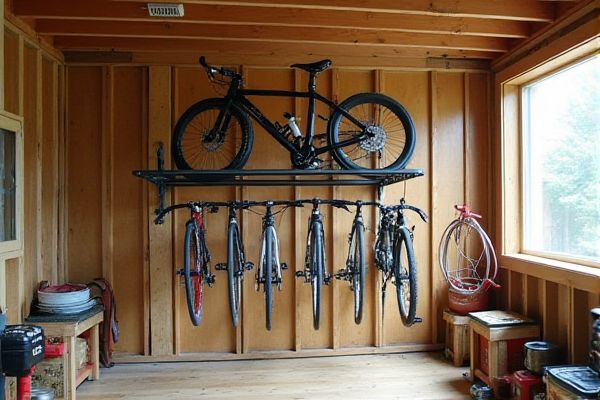
A gravity-fed bike rack relies on the natural force of gravity to securely hold bikes in place, offering a simple and low-maintenance solution ideal for quick loading and unloading, while a pulley system uses mechanical advantage to lift and store bikes vertically, maximizing space but requiring more effort and installation complexity. Explore the rest of the article to discover which bike storage option best suits your needs and lifestyle.
Table of Comparison
| Feature | Gravity-Fed Bike Rack | Pulley System |
|---|---|---|
| Operation | Uses gravity to hold and release bikes | Uses ropes and pulleys for lifting and lowering bikes |
| Installation | Simple, often fixed in place | Requires mounting pulleys and rope setup |
| Space Efficiency | Compact, limited to vertical stacking | Maximizes vertical storage by lifting bikes overhead |
| Ease of Use | Quick load/unload, minimal effort | Requires pulley operation, moderate effort |
| Cost | Generally low to moderate | Varies; typically moderate due to hardware |
| Maintenance | Low; mainly cleaning and inspection | Moderate; includes rope and pulley checks |
| Best Use Case | Residential or small bike storage | Garages or high-ceiling storage areas |
Introduction to Bike Storage Solutions
Gravity-fed bike racks use sloped tracks to allow bicycles to roll into designated slots, optimizing space and enabling quick storage without complex mechanisms. Pulley systems employ ropes and pulleys to vertically lift and suspend bikes, maximizing storage in limited areas by utilizing ceiling or wall space. Both solutions address urban storage challenges, with gravity-fed racks offering ease of use and pulley systems providing greater vertical space efficiency.
Overview of Gravity-Fed Bike Racks
Gravity-fed bike racks use the natural force of gravity to securely hold bicycles in place without the need for complex mechanisms or manual lifting. These racks allow you to easily slide your bike down a sloped track where it locks in position by weight, providing a simple and efficient storage solution ideal for garages or bike rooms. Compared to pulley systems, gravity-fed racks require less maintenance and offer quick, intuitive access while maximizing space.
Overview of Pulley System Bike Racks
Pulley system bike racks utilize a cable and pulley mechanism to lift and lower bicycles vertically, maximizing storage space in garages or small areas. These racks provide easy access by allowing smooth, controlled movement and can support heavy bikes effortlessly. Compared to gravity-fed racks, pulley systems offer enhanced safety features and adjustable height settings for versatile bike storage solutions.
Space Efficiency Comparison
Gravity-fed bike racks maximize space efficiency by stacking bikes vertically using the natural force of gravity, allowing multiple bicycles to be stored in a compact footprint without the need for extra mechanical components. Pulley systems require additional room for cables, pulleys, and often a more complex setup, which can reduce the overall usable storage area. Your choice should consider available space and ease of access, with gravity-fed options generally providing better space optimization for smaller storage environments.
Ease of Installation
A gravity-fed bike rack requires minimal installation effort as it often relies on simple mounting brackets or floor stands without complex mechanisms. Pulley systems, by contrast, involve more intricate setups with cables, pulleys, and ceiling attachments, demanding precise alignment and secure fixing points. Your choice depends on whether you prioritize quick, hassle-free installation or a more versatile lifting mechanism.
Usability and Convenience
Gravity-fed bike racks offer straightforward usability by allowing bikes to be loaded and unloaded with minimal effort, making them ideal for quick stops and casual use. Pulley systems provide enhanced convenience for lifting and storing bikes in tight spaces, reducing strain on your body, especially when handling heavier bikes. Your choice depends on whether ease of access or space-saving functionality aligns better with your routine.
Safety and Stability Features
Gravity-fed bike racks enhance safety with a stable base that uses the bike's weight for secure positioning, minimizing movement during transport. Pulley systems rely on adjustable straps and tension control to secure bikes, offering customization but requiring proper handling to maintain stability. Your choice should consider the ease of securing your bike and the level of movement prevention needed for safe transport.
Cost and Maintenance Considerations
Gravity-fed bike racks generally offer lower upfront costs and require minimal maintenance due to their simple, mechanical design without moving parts. Pulley systems involve higher initial investment and ongoing maintenance to ensure cable tension and pulley function remain optimal, which can increase long-term expenses. Choosing between the two depends on budget constraints and the importance of low-maintenance operations in the specific storage environment.
Suitability for Different Spaces and Bikes
Gravity-fed bike racks excel in compact urban spaces and are ideal for standard bicycles due to their simple load-and-unload process, making them perfect for residential garages and small commercial areas. Pulley systems offer versatility for diverse bike types, including mountain, road, and electric bikes, accommodating ceiling heights and uneven spaces in garages or outdoor sheds. Choosing between the two depends on spatial constraints and bike variety, with gravity-fed racks optimizing straightforward, tight spaces and pulley systems providing flexible vertical storage solutions.
Choosing the Right Bike Rack System for You
A gravity-fed bike rack uses natural force to securely hold bikes in place without mechanical assistance, offering a simple, cost-effective solution for easy loading and unloading. Pulley systems provide enhanced versatility and storage efficiency, especially in tight spaces, by allowing you to lift bikes vertically with minimal effort. Consider your storage space, frequency of use, and physical capability to determine which bike rack system best suits your needs and lifestyle.
 homyna.com
homyna.com